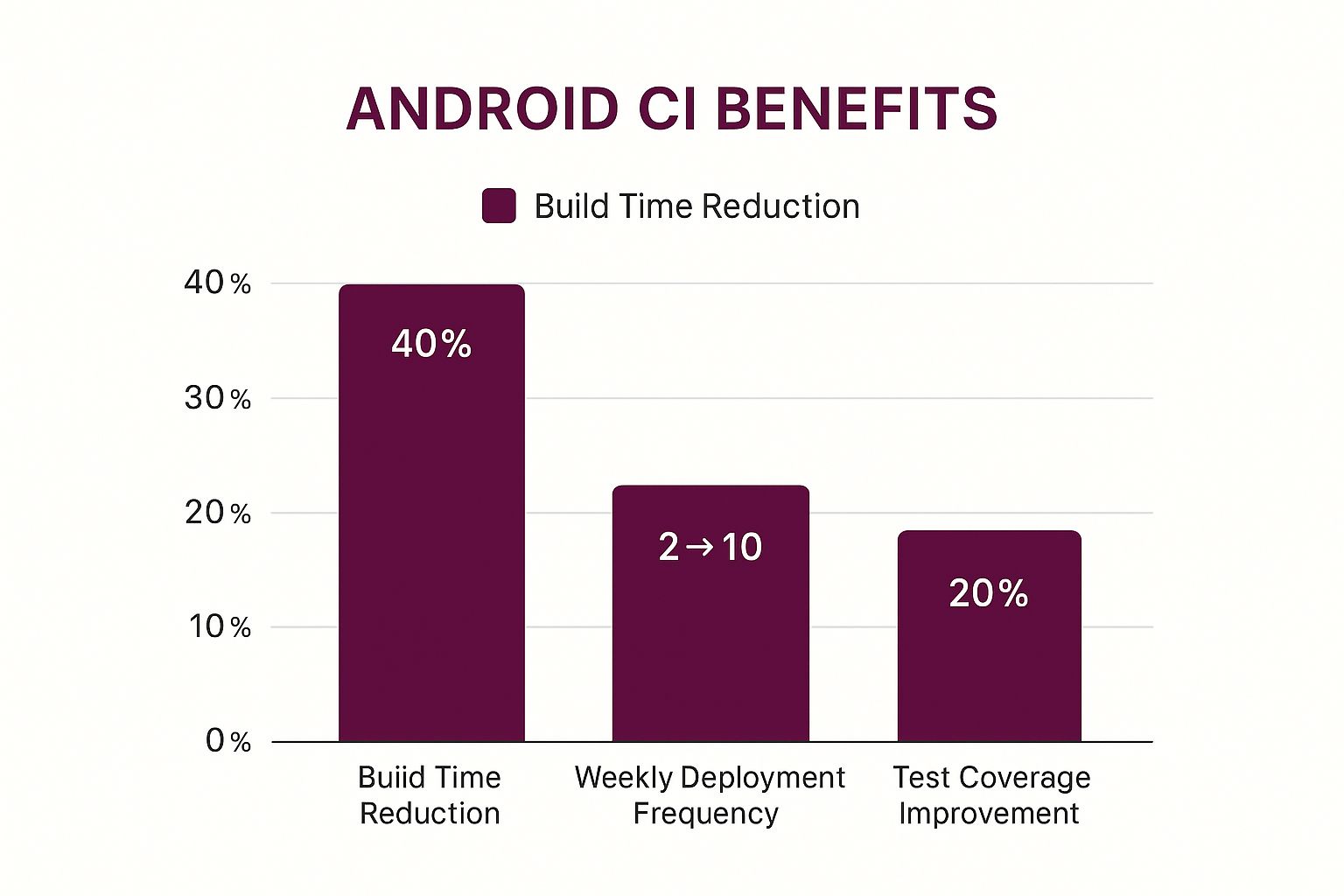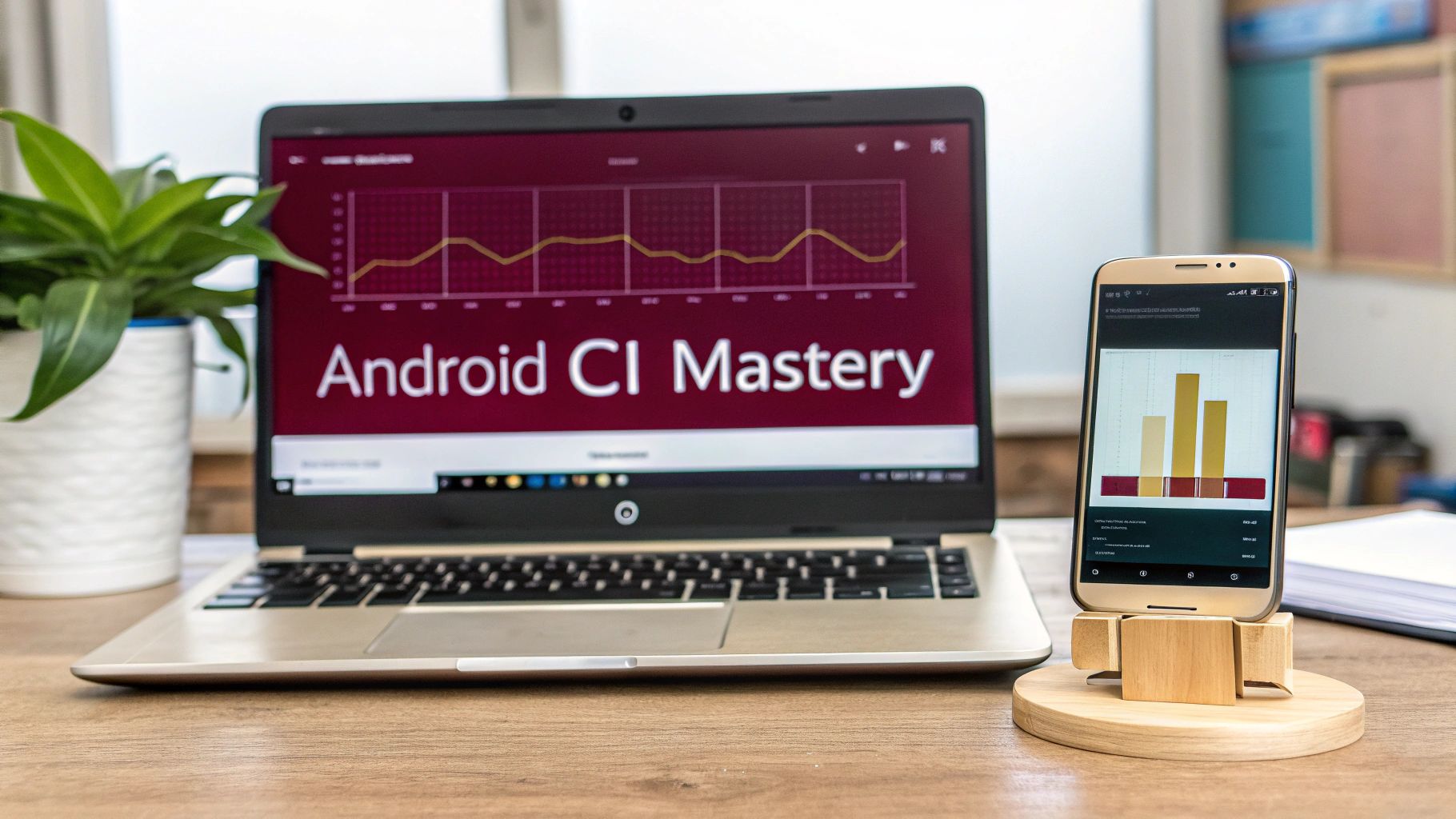Understanding Continuous Integration For Android Development

Continuous Integration (CI) is a core practice for Android development teams looking to build better apps more efficiently. It acts like an automated quality control system, constantly checking code for errors and streamlining the development process. This allows developers to focus on creating features, rather than troubleshooting integration problems.
Why CI Matters in Android Development
Android development has unique challenges, such as device fragmentation and intricate build processes. CI helps tackle these by automating the build, test, and deployment stages. Imagine manually testing an app on hundreds of Android devices. CI automates this, saving significant time and effort. It also catches bugs early in the development lifecycle, making them cheaper and easier to fix.
This leads to real benefits for development teams. Some teams report reducing bugs by up to 60% and halving release cycles after adopting CI. Automated testing within a CI pipeline also ensures consistent code quality and improves team collaboration. This allows more frequent updates and faster responses to user feedback. The increasing use of CI tools highlights these advantages. As of 2023, about 50% of Android developers regularly use CI/CD tools, with another 25% having recently adopted them. More detailed statistics can be found here: Best CI Tools
Core Principles of Effective Android CI
Several key principles underpin effective CI for Android development.
-
Automation: Automating tasks like building, testing, and deploying code minimizes manual errors and frees up developers to concentrate on coding. This includes using build scripts to manage Android’s complexities and integrating with platforms like the Google Play Console.
-
Frequent Integration: Regularly merging code changes into a shared repository helps detect integration problems early. This prevents minor issues from becoming major headaches later on.
-
Comprehensive Testing: This involves various tests, including unit tests, integration tests, and UI tests. A strong testing suite ensures code quality and catches bugs before they impact users.
These principles, when implemented correctly, create a more efficient and dependable workflow for Android development teams.
Essential CI Tools That Actually Work For Android Projects
Choosing the right Continuous Integration (CI) tool can significantly impact your Android project’s success. It’s not just about automating builds; it’s about finding a platform that smoothly integrates with your current workflow and adapts as your project expands. Let’s examine some top CI tools and explore their advantages and disadvantages for Android development.
Popular CI/CD Platforms
-
Jenkins: Jenkins is a highly adaptable open-source option. It boasts broad plugin support for Android SDK integration and flexible configuration. However, setting up and maintaining Jenkins can demand significant resources, often requiring dedicated server administration.
-
GitHub Actions: Closely integrated with GitHub repositories, Actions provides a user-friendly CI/CD solution for projects already hosted on the platform. It delivers excellent Android support and simplifies workflow automation within the GitHub ecosystem.
-
GitLab CI: Similar to GitHub Actions, GitLab CI is deeply embedded within GitLab. It offers a solid CI/CD pipeline with features such as auto-scaling and a built-in container registry, making it well-suited for complex Android projects.
-
Cloud-Based Solutions (Bitrise, CircleCI, etc.): Platforms like Bitrise and CircleCI provide managed CI/CD environments tailored for mobile development. They offer features like device farms for testing on various Android versions and simplified configuration for standard mobile workflows. However, these platforms usually involve subscription fees, which can be a consideration for smaller teams or projects.
Evaluating CI Tools for Android
When selecting a CI tool for your Android project, keep these factors in mind:
-
Android SDK Support: Confirm that the tool smoothly integrates with the Android SDK and supports key build tools and dependencies.
-
Ease of Use: A clear interface and simple configuration can greatly reduce the learning curve for your team.
-
Scalability: As your project expands, your CI tool needs to handle increasing build complexity and testing demands.
-
Cost: Carefully consider the pricing structure and ensure it fits within your budget, particularly for cloud-based options.
To help illustrate the various options available, take a look at the table below comparing some popular CI tools:
To help you evaluate your CI options, we’ve assembled a comparison of some popular tools:
| Tool | Android Support | Pricing Model | Key Features | Best For |
|---|---|---|---|---|
| Jenkins | Extensive via plugins | Open Source (free) | Highly customizable, large community | Teams comfortable with self-hosting and system administration |
| GitHub Actions | Excellent native integration | Free for public repositories, paid plans for private repositories | Tight GitHub integration, simplified workflows | Projects hosted on GitHub |
| GitLab CI | Robust built-in support | Free for public repositories, paid plans for private repositories | Integrated container registry, auto-scaling | Projects hosted on GitLab |
| Bitrise | Mobile-focused features | Subscription-based | Device farms, mobile-specific workflows | Mobile-first teams needing device testing and managed infrastructure |
| CircleCI | Strong Android support | Free tier available, paid plans for larger projects | Cloud-based, configurable workflows | Projects seeking a balance of flexibility and ease of use |
This table highlights the different strengths of each platform, allowing you to quickly assess which might best suit your needs. While Jenkins provides flexibility, it comes with greater administrative overhead. GitHub and GitLab CI offer tight integration within their respective ecosystems, while cloud solutions provide managed convenience but come with associated costs.
Why Teams Migrate Between Platforms
Teams often switch CI platforms due to changing project needs. A team might outgrow Jenkins’ open-source model and adopt a cloud-based solution for enhanced scalability and managed infrastructure. Conversely, some teams might shift from a cloud platform to a self-hosted solution like Jenkins to gain more control and reduce expenses. Check out our guide on How to master Android CI.
The following infographic visually represents the advantages experienced by Android teams who’ve implemented CI practices: it highlights the decrease in build time, rise in deployment frequency, and improvements in test coverage.

This data demonstrates how CI can significantly enhance efficiency. A 40% reduction in build time, combined with a leap from 2 to 10 weekly deployments, signifies a considerably faster development cycle. Moreover, the 20% rise in test coverage shows a commitment to better code quality. Successfully transitioning between CI platforms requires careful planning and consideration of your project’s specific requirements. You might be interested in: how Duolingo sped up their Android and iOS CI builds.
Building Your First Android CI Pipeline That Works

Creating a continuous integration (CI) pipeline for your Android projects might seem like a complex undertaking. However, by breaking down the process into smaller, manageable steps, any team can achieve a streamlined and efficient workflow. This section will provide a practical guide to setting up your first Android CI pipeline.
Configuring Your Build Scripts
The core of any CI pipeline is a well-structured build script. For Android development, Gradle is the commonly used build automation system. Your Gradle script defines the entire build process, from compiling code and managing dependencies to generating various build variants. It’s crucial to ensure your script can handle the nuances of Android builds, like managing different build flavors for different versions of your app.
Automating Your Testing
Automated testing plays a vital role in early bug detection. Integrating testing frameworks like JUnit (for unit tests) and Espresso (for UI tests) into your CI pipeline ensures every code change is automatically tested. This significantly reduces the risk of introducing bugs into your production code. For instance, configuring your pipeline to execute all unit tests after each code commit provides immediate feedback and helps identify issues quickly.
Streamlining Your Deployment Workflow
After building and testing your app, the next crucial step is deployment. A well-configured CI pipeline can automate this process, allowing you to push updates to the Google Play Console with minimal manual intervention. Setting up different deployment channels, such as beta testing tracks, enables staged rollouts and targeted testing. This controlled approach minimizes potential disruptions for your users. Research indicates that teams using comprehensive CI pipelines see a 73% reduction in production bugs and a 2.5x faster time-to-market compared to teams relying on manual processes. You can find the full research here.
Handling Build Variants and Dependencies
Android projects often involve multiple build variants, like free and paid versions. Your CI pipeline needs to handle these complexities effectively. With the proper configuration, it can automatically build all required variants. Efficient dependency management is equally important. Leveraging dependency caching mechanisms within Gradle can dramatically optimize build times by avoiding redundant downloads, especially for unchanged dependencies. For a more in-depth guide, check out How to Master CI/CD Pipelines.
Prioritizing Security Best Practices
Security should be a top priority in any development process. Secure your CI environment to protect sensitive information such as API keys and signing certificates. Using environment variables and secure storage mechanisms provided by your CI platform can effectively safeguard this data, preventing unauthorized access and ensuring the integrity of your application. This reinforces the idea that a robust CI pipeline not only streamlines your workflow but also bolsters the security of your entire development lifecycle.
Advanced Testing Strategies That Catch Real Issues
Building a solid continuous integration (CI) pipeline for your Android project goes beyond basic unit tests. To truly enhance your app’s quality and catch those subtle bugs that often go unnoticed, you need to implement advanced testing strategies. This section explores techniques that can significantly improve your CI process.
UI Testing With Espresso in CI Environments
UI testing, often perceived as challenging within CI, is essential for a smooth user experience. Espresso, the official Android UI testing framework, provides a robust solution for automated UI testing. Integrating Espresso into your CI pipeline lets you simulate user interactions and verify the proper functioning of your app’s UI components.
This approach helps identify visual regressions and usability issues before they impact your users. For example, consider a button that becomes unresponsive after a particular user flow. Espresso can detect and flag this problem during the CI process, preventing user frustration.
Integration Testing: Catching What Unit Tests Miss
While unit tests examine individual components in isolation, integration tests evaluate how these components work together. By testing the interactions between different parts of your app, you can uncover issues related to data flow, inter-module communication, and overall system behavior. This complements unit testing and provides a more comprehensive view of potential problems.
Automating Performance Testing and Preventing Regressions
Performance testing is crucial for maintaining a responsive and efficient app. Automating these tests within your CI pipeline helps detect performance regressions early. By consistently monitoring metrics like load times, frame rates, and memory usage, you can track performance trends and identify areas for optimization.
This proactive approach prevents performance issues from affecting users in production. Teams that adopt comprehensive automated testing strategies often experience significant improvements in app stability and reliability. They report 68% fewer critical bugs in production and a 45% reduction in hotfix releases. Learn more about the impact of automated testing.
Parallel Testing and Device Farms for Enhanced Coverage
Parallel testing, running multiple tests simultaneously, can drastically reduce your CI pipeline’s execution time. Distributing tests across multiple machines or virtual devices speeds up the testing process and provides faster feedback. See also: How to master testing in CI.
Combining parallel testing with device farms, which offer access to a variety of Android devices and OS versions, expands test coverage across different configurations. This ensures your app works correctly on various hardware and software environments, improving compatibility and minimizing user issues.
Managing Flaky Tests and Maintaining Reliability
Flaky tests, those that inconsistently pass or fail without code changes, are a common CI hurdle. These tests can undermine confidence in your test suite and hinder development. Implementing strategies to identify and address flaky tests is crucial.
Techniques like retrying failed tests or isolating flaky tests for investigation can enhance overall test reliability. Analyzing the root causes of flakiness, such as timing issues or dependencies on external resources, can lead to more robust tests and a more stable CI pipeline. These methods allow development teams to maintain high test confidence without sacrificing speed.
Navigating Cross-Platform CI With Modern Android Development

Mobile development is a constantly evolving field, and continuous integration (CI) requirements are changing right alongside it. The rise of cross-platform frameworks like React Native and Flutter has significantly contributed to this shift. These frameworks allow developers to build apps for both Android and iOS from a single codebase, streamlining the development process. However, this efficiency introduces new complexities for CI.
Adapting CI for Cross-Platform Projects
Cross-platform development presents unique CI challenges. Instead of building a single Android app, developers now manage builds for multiple platforms within one project. This requires a CI pipeline capable of handling diverse build processes, testing frameworks, and deployment targets. Maintaining consistency between platform-specific implementations is also crucial for a unified user experience.
The growing popularity of cross-platform solutions highlights the need for adapted CI practices. This directly influences the adoption of CI tools in Android development. React Native, currently the leading non-native framework on the App Store and second on Google Play, relies on CI tools to efficiently manage its complex builds and deployments. For more information on cross-platform trends, see this article: Cross-Platform Development Trends.
Strategies for Hybrid CI Pipelines
Many development teams adopt a hybrid approach, juggling both native Android and cross-platform projects. This necessitates a CI strategy that supports both without excessive complexity. A key strategy is to create separate CI pipelines for each platform while sharing common components like testing libraries or deployment scripts. This modular approach improves maintainability and allows platform-specific customization.
Efficient dependency management is another critical factor, especially with mixed native and cross-platform libraries. Using tools like Gradle for Android and npm or yarn for cross-platform projects helps organize builds and prevent conflicts.
Shared Testing and Deployment Workflows
Shared testing strategies are essential for hybrid projects. Cross-platform testing frameworks like Detox or Appium allow writing tests once and running them on both Android and iOS, reducing duplication and ensuring consistent functionality. Similarly, automating deployment workflows simplifies multi-platform releases. Tools like Fastlane or CodePushGo automate the process of building, signing, and distributing apps to both the Google Play Store and Apple App Store. For further insights, check out this article: Blue-Green Deployment Strategy.
Maintaining Consistency and Managing Complexity
Effective use of CI tools is key to maintaining consistency between native and cross-platform implementations. Automated UI tests can verify the visual and functional equivalence of your app across platforms, catching discrepancies early. Managing the increased complexity of multi-platform releases is equally critical.
By employing robust version control and branching strategies, you can coordinate releases and ensure thorough testing before they reach users. This reduces risks and streamlines the management of multiple release cycles. These strategies ensure your CI process remains organized and efficient as your project grows.
Future-Proofing Your Android CI For AI And Emerging Tech
Integrating Artificial Intelligence (AI) and Machine Learning (ML) into Android apps is quickly becoming standard practice. This presents both exciting opportunities and unique challenges for Android developers. As AI and ML become more common, ensuring your Continuous Integration (CI) pipeline can handle these advancements is essential for future success.
Adapting CI for AI-Powered Android Apps
AI-driven features often involve complex dependencies, large model files, and unique testing requirements. Traditional CI pipelines may struggle to manage these aspects efficiently. For example, integrating large ML models can significantly increase build times if not handled correctly. This requires strategies like model optimization and efficient caching mechanisms within your CI workflow.
Ensuring consistent AI behavior across diverse Android devices and OS versions is also increasingly important. Testing AI functionalities demands a different approach compared to traditional app features. Consider image recognition: testing requires providing various images and verifying the accuracy of the AI’s output – more complex than checking a button click.
Emerging trends in Android development, like AI/ML integration and 5G advancements, highlight the need for more streamlined development processes, including robust continuous integration. The combination of AI-driven app development and sophisticated CI tools will be key to maintaining app quality and user satisfaction. Explore this topic further: Top Trends in Android App Development.
Model Deployment Strategies and Performance Monitoring
Efficiently deploying AI models within a CI pipeline requires careful planning. Strategies like on-device deployment, cloud-based inference, or a hybrid approach should be considered based on the app’s requirements. Each method presents unique challenges for CI integration, from managing model versioning to ensuring seamless communication between the app and the AI service.
Performance monitoring of ML features in production is also vital. Your CI pipeline can integrate tools to track model accuracy, latency, and resource utilization. This data helps detect performance degradation or unexpected AI behavior in real-world scenarios.
Automated Testing for AI Functionality
Testing AI functionality requires specific strategies different from traditional app testing. Automated tests should cover model accuracy, prediction consistency, and handling of edge cases. For example, a language translation app needs testing with various phrases and languages to ensure correct translations and handling of ambiguities.
Data drift, where production input data deviates from the training data, can significantly impact model performance. Integrating data drift detection into your CI pipeline allows for proactive retraining and model updates, preventing accuracy degradation. Read also: CI/CD Security Best Practices.
Preparing Your CI Infrastructure
Future-proofing your Android CI for AI requires several key adjustments. Ensure your CI system can handle large model files and datasets efficiently. Using cloud storage or artifact repositories within your CI pipeline can streamline model management and reduce build times.
Adopt containerization technologies like Docker to create consistent build and testing environments. This simplifies dependency management and ensures reproducible builds, regardless of the underlying hardware.
Finally, consider specialized CI/CD platforms with features tailored for mobile development and AI integration. Some platforms may include device farms for simplified testing on different Android versions or have built-in integrations with machine learning platforms.
By taking these steps, you can build a robust and adaptable CI pipeline prepared for the evolving Android landscape. This will enable you to effectively integrate AI and emerging technologies into your apps while maintaining the speed and reliability your development process requires.
Key Takeaways
This section provides practical strategies for achieving continuous integration (CI) success in Android development. These strategies are based on real-world experience and proven methods, offering actionable checklists, realistic goals, and clear indicators to track progress and celebrate successes. The focus is on practical steps you can implement immediately to optimize your team’s workflow and effectively scale your CI practices.
Checklist For Immediate CI Implementation
Implementing CI for Android doesn’t have to be a daunting task. Here’s a checklist to get you started:
-
Choose the Right CI Tool: Evaluate various CI tools like Jenkins, GitHub Actions, GitLab CI, or cloud-based options such as Bitrise or CircleCI. Consider factors like Android SDK support, ease of use, scalability, and cost.
-
Configure Build Scripts: Establish a robust build script using Gradle to define the build process, manage dependencies, and generate different build variants for your Android app.
-
Automate Testing: Integrate automated testing frameworks like JUnit and Espresso to test code changes after each commit. This ensures early bug detection and improves overall code quality.
-
Streamline Deployment: Automate the deployment process to the Google Play Console using your chosen CI tool. This enables staged rollouts and targeted testing through different deployment channels.
-
Secure Your CI Environment: Protect sensitive data such as API keys and signing certificates by leveraging environment variables and secure storage mechanisms within your CI platform.
Setting Realistic Goals and Measuring Progress
Start with achievable goals and gradually expand your CI implementation. Begin by automating fundamental tasks like building and running unit tests. As your team gains experience, incorporate UI testing, integration testing, and automated deployment.
Track key metrics such as build time, test coverage, and deployment frequency. Studies have shown that implementing comprehensive CI pipelines can significantly reduce production bugs by 73% and increase speed-to-market by 2.5x. Aim for similar improvements and adjust your strategies as needed.
To help you track and optimize your CI performance, the following table provides a checklist of key areas and strategies:
To help you track and optimize your CI performance, the following table provides a checklist of key areas and strategies:
CI Performance Optimization Checklist: Key performance metrics and optimization strategies for Android CI pipelines with expected improvements.
| Optimization Area | Strategy | Expected Improvement | Implementation Difficulty |
|---|---|---|---|
| Build Time | Optimize Gradle scripts, leverage caching, upgrade build tools | 20-30% reduction | Medium |
| Test Coverage | Implement UI and integration tests, utilize device farms | 10-20% increase | Medium |
| Deployment Frequency | Automate deployments, use staged rollouts | 2x-5x increase | Easy |
| Test Reliability | Manage flaky tests, isolate and investigate failures | 5-10% improvement | Hard |
This checklist offers measurable indicators to track your CI effectiveness. Focus on incremental improvements, remembering that small gains accumulate over time. For instance, Duolingo iteratively improved its CI process, eventually reducing Android and iOS build times by 68%, from 50 minutes down to 16 minutes.
Long-Term Success and Scaling CI Practices
As your Android projects expand, your CI practices should scale accordingly. Adopt advanced testing strategies like parallel testing and device farms to maintain fast feedback loops even as test complexity increases. Manage flaky tests effectively to ensure your test suite remains reliable and doesn’t hinder development speed.
Stay current by adapting your CI pipeline for emerging technologies. This includes managing large model files, automating AI functionality testing, and monitoring performance in production. Continuously optimizing your CI process empowers your team to deliver high-quality Android apps faster and more efficiently.
CodePushGo can streamline your deployment process for React Native applications, offering instant, background deployments that comply with app store guidelines. Its seamless integration with popular CI/CD pipelines allows for fast deployments, smart updates, and a one-click rollback feature. Learn more about how CodePushGo can enhance your Android CI workflow at https://codepushgo.com.




